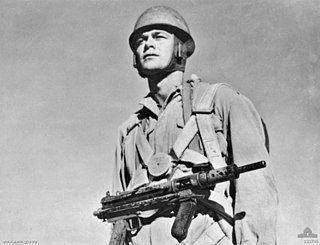 W
WThe Austen was a 9×19mm Australian submachine gun derived from the British Sten gun developed during the Second World War. In total 19,914 Austens were produced during the war by Diecasters Ltd of Melbourne and W. T. Carmichael Ltd of Sydney.
 W
WBechowiec was a Polish World War II submachine gun developed and produced by the underground Bataliony Chłopskie resistance organisation. It was designed in 1943 by Henryk Strąpoć and was produced in underground facilities in the area of Ostrowiec Świętokrzyski. Its name was coined after the Bataliony Chłopskie organization members who were informally called bechowiec.
 W
WThe Beretta Model 1918 was a submachine gun that entered service in 1918 with the Italian armed forces. Designed initially as a semi-automatic rifle, the weapon came with an overhead inserted magazine, an unconventional design based on the simplicity of allowing a spent round to be replaced using assistance from gravity. The gun was made from half of a Villar-Perosa aircraft submachine gun, and as such it can be considered the first submachine gun issued to and used by the Italian armed forces, and is possibly the first SMG used as a general-issue combat weapon. Certain sources say that it saw service a few weeks before the German MP 18; the exact date remains debated.
 W
WThe Błyskawica, was a submachine gun produced by the Armia Krajowa, or Home Army, a Polish resistance movement fighting the Germans in occupied Poland Together with a Polish version of the Sten sub-machine gun, with which it shares some design elements, it was the only weapon mass-produced covertly in occupied Europe during World War II.
 W
WThe Danuvia 39M/43M was a Hungarian submachine gun designed by Pál Király in the late 1930s.
 W
WThe EMP 44 was a prototype, all-metal submachine gun produced by Erma Werke in 1943. It was rejected by the Heereswaffenamt.
 W
WThe German machine pistol EMP also known as MPE was produced by the Erma factory, and was based on designs acquired from Heinrich Vollmer. The gun was produced from 1931 to 1938 in roughly 10,000 exemplars and exported to Spain, Mexico, China and Yugoslavia, but also used domestically by the SS. It was produced under license in Spain by the arsenal of A Coruña under the designation M41/44.
 W
WThe Experimental Model 2 Submachine Gun was a pre–World War II experimental submachine gun of Japanese origin chambered in the 8mm Nambu round.
 W
WThe FNAB-43 is an Italian designed and developed submachine gun manufactured from 1943 to 1945. The first prototype was built in 1942 and the 7,000 built by the FNA-B were issued to German and Italian RSI units fighting in Northern Italy. The FNAB-43 was an expensive weapon to manufacture as it used extensive milling and precision engineering in its manufacture.
 W
WKIS was the name of a Polish submachine gun from the time of the Second World War. It was designed and manufactured by engineers in Jan Piwnik's "Ponury" ("Grim") guerrilla unit that was operating in Holy Cross Mountains region.
 W
WThe Hyde-Inland M2 was a United States submachine gun design submitted for trials at Aberdeen Proving Ground in February 1941. Work was undertaken by General Motors Inland Manufacturing Division to develop workable prototypes of George Hyde's design patented in 1935. The model first submitted for trials in April 1942 was designated the Hyde-Inland 1. Trials revealed the design was superior to the M1 submachine gun in mud and dirt tests, and its accuracy in full-automatic firing was better than any other submachine gun tested at the time. An improved Hyde-Inland 2 was designated U.S. Submachine gun, Caliber .45, M2 as a substitute standard for the M1 Thompson in April 1942. As Inland's manufacturing capacity became focused on M1 carbine production, the US Army contracted M2 production to Marlin Firearms in July 1942. Marlin began production in May 1943. Marlin's production failed to match the trials prototype performance; and Marlin's original contract for 164,450 M2s was canceled in 1943 upon adoption of the M3 submachine gun. The M2 is chambered for the .45 ACP cartridge and used the same 20- or 30-round magazine as the Thompson. Its cyclic rate of fire is 570 rounds per minute. None of the approximately 400 manufactured were issued by any branches of the United States military.
 W
WThe M3 is an American .45-caliber submachine gun adopted for U.S. Army service on 12 December 1942, as the United States Submachine Gun, Cal. .45, M3. The M3 was chambered for the same .45 ACP round fired by the Thompson submachine gun, but was cheaper to produce and lighter, although, contrary to popular belief, it was less accurate. The M3 was commonly referred to as the "Grease Gun" or simply "the Greaser", owing to its visual similarity to the mechanic's tool.
 W
WThe .45 Reising submachine gun was manufactured by Harrington & Richardson (H&R) Arms Company in Worcester, Massachusetts, USA, and was designed and patented by Eugene Reising in 1940. The three versions of the weapon were the Model 50, the folding stock Model 55, and the semiautomatic Model 60 rifle. Over 100,000 Reisings were ordered during World War II, and were initially used by the United States Navy, Marine Corps, and the United States Coast Guard, though some were shipped to Canadian, Soviet, and other allied forces to fight the Axis powers.
 W
WThe MAS-38 is a French submachine gun designed in the 1930s and used by French and German forces during the Second World War. It was derived from a small arms development program that took place between 1918 and 1922 under the control of the Service Technique de l'Armement. A submachine gun, a light machine gun and a semiautomatic rifle were developed to replace all the existing small arms. Budgetary constraints due to choices like building the Maginot Line led to the delay of adoption of these new arms except for the LMG 1924.
 W
WPistolet maszynowy wz. 39 Mors was a Polish submachine gun designed by Piotr Wilniewczyc and Jan Skrzypiński between 1936 and 1938. It was to have become the standard submachine gun of the Polish Army some time in the 1940s. However, its production was halted by the 1939 Invasion of Poland and World War II.
 W
WThe MP 18 manufactured by Theodor Bergmann Abteilung Waffenbau was the first submachine gun used in combat. It was introduced into service in 1918 by the German Army during World War I as the primary weapon of the Sturmtruppen, assault groups specialized in trench combat. Although MP 18 production ended in the 1920s, its design formed the basis of most submachine guns manufactured between 1920 and 1960.
 W
WThe MP 40 is a submachine gun chambered for the 9×19mm Parabellum cartridge. It was developed in Nazi Germany and used extensively by the Axis powers during World War II.
 W
WThe 9×19mm MP 3008 was a German substitute standard submachine gun manufactured toward the end of World War II in early 1945.
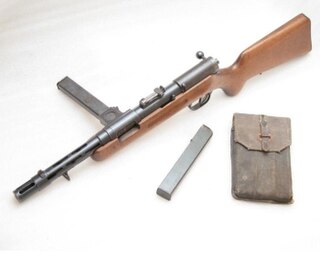 W
WThe MP35 was a submachine gun used by the Wehrmacht, Waffen-SS and German police both before and during World War II. It was developed in the early 1930s by Emil Bergmann and manufactured at the Bergmann company in Suhl.
 W
WThe Onorati SMG is a two-barrel Italian prototype submachine gun. A pistol calibre rifle variant also existed.
 W
WThe OVP was a submachine gun developed in Italy.
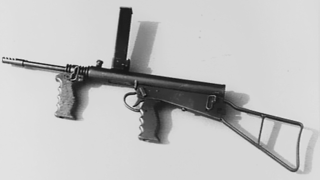 W
WThe Owen gun, which was known officially as the Owen machine carbine, was an Australian submachine gun designed by Evelyn Owen in 1939. The Owen was the only entirely Australian-designed and constructed service submachine gun of World War II and was used by the Australian Army from 1943 until the mid-1960s.
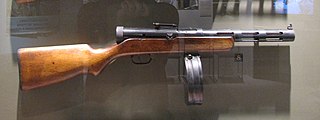 W
WThe PPD is a submachine gun originally designed in 1934 by Vasily Degtyaryov. The PPD had a conventional wooden stock, fired from an open bolt, and was capable of selective fire. It was replaced by the PPSh-41.
 W
WThe PPS is a family of Soviet submachine guns chambered in 7.62×25mm Tokarev, developed by Alexei Sudayev as a low-cost personal defense weapon for reconnaissance units, vehicle crews and support service personnel.
 W
WThe PPSh-41 is a Soviet submachine gun designed by Georgy Shpagin as a cheap, reliable, and simplified alternative to the PPD-40. A common Russian nickname for the weapon is "papasha" (папа́ша), meaning "daddy", and it was sometimes called the "burp gun" because of its high fire rate.
 W
WThe Sterling submachine gun is a British submachine gun. It was tested with the British Army in 1944–1945 as a replacement for the Sten but it did not start to replace it until 1953. A successful and reliable design, it remained as standard issue with the British Army until 1994, when it was phased out as the L85A1 assault rifle was phased in.
 W
WThe Thompson submachine gun is a blowback-operated, air-cooled, magazine-fed selective-fire submachine gun, invented by the United States Army Brigadier general John T. Thompson in 1918. It was originally designed to break the stalemate of trench warfare of World War I, but was not finished until after the war ended.
 W
WThe Type 100 submachine gun was a Japanese submachine gun used during World War II and the only submachine gun produced by Japan in any quantity. It was made in two basic variants referred to by American and British observers as the Type 100/40 and the Type 100/44, the latter also known as the Type 100 (Simplified). A small number of the earlier version were converted into using folding stock, sometimes referred to by the Allies as the Type 100 Navy, which was made for parachutists.
 W
WThe TZ-45 was an Italian submachine gun produced in small numbers between 1944 and 1945, with an estimated 6,000 made.
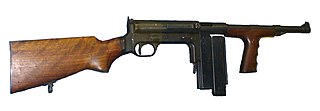 W
WThe United Defense M42, sometimes known as the Marlin for the company that did the actual manufacturing, was an American submachine gun used during World War II. It was produced from 1942 to 1943 by United Defense Supply Corp. for possible issue as a replacement for the Thompson submachine gun and was used by agents of the Office of Strategic Services (OSS). However, its usage was limited, and the Thompson continued to see service until the end of the war, alongside the M3 submachine gun, which was designed around the same time as the M42.
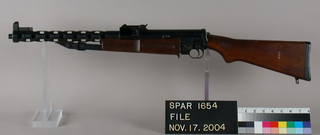 W
WThe ZK-383 is a submachine gun developed by the Koucký brothers, who worked at the pre-war Československá zbrojovka, akc.spol. arms factory in Brno, Czechoslovakia. It was produced at a slow rate from 1938 onwards and was exported as far away as Bolivia and Venezuela.